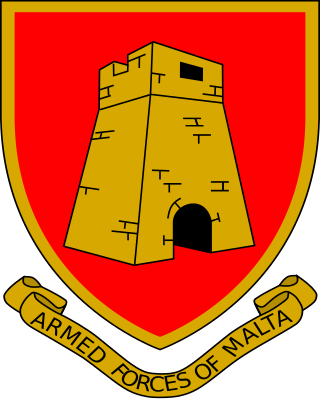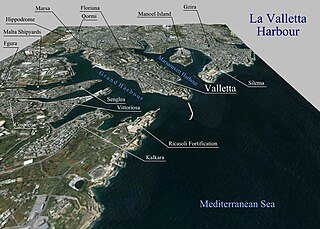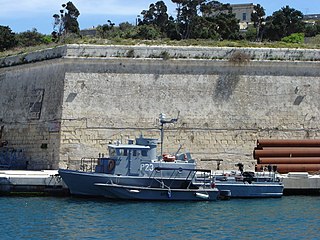
Floriana, also known by its title Borgo Vilhena, is a fortified town in the Port Region area of Malta, just outside the capital city Valletta. It has a population of 2,205 as of March 2014. Floriana is the birthplace of many famous Maltese, amongst which the composer of the national anthem, 'L-Innu Malti', Robert Samut; former Bishop of Malta Dun Mauro Caruana, the poets Oliver Friggieri and Maria Grech Ganado, the writer and politician Herbert Ganado and Swedish Idol winner Kevin Borg.

Pietà is a small harbour town in the Eastern Region of Malta, located near the outskirts of the capital city Valletta.

The Armed Forces of Malta is the name given to the combined armed services of Malta. The AFM is a brigade sized organisation consisting of a headquarters and three separate battalions, with minimal air and naval forces. Since Malta is the guardian of the European Union's southernmost border, the AFM has an active role in border control.

Fort Manoel is a star fort on Manoel Island in Gżira, Malta. It was built in the 18th century by the Order of Saint John, during the reign of Grand Master António Manoel de Vilhena, after whom it is named. Fort Manoel is located to the north west of Valletta, and commands Marsamxett Harbour and the anchorage of Sliema Creek. The fort is an example of Baroque architecture, and was designed with both functionality and aesthetics in mind.

Fort Saint Elmo is a star fort in Valletta, Malta. It stands on the seaward shore of the Sciberras Peninsula that divides Marsamxett Harbour from Grand Harbour, and commands the entrances to both harbours along with Fort Tigné and Fort Ricasoli. It is best known for its role in the Great Siege of Malta in 1565.

The Grand Harbour, also known as the Port of Marsa, is a natural harbour on the island of Malta. It has been substantially modified over the years with extensive docks, wharves, and fortifications.

Marsamxett Harbour, historically also referred to as Marsamuscetto, is a natural harbour on the island of Malta. It is located to the north of the larger Grand Harbour. The harbour is generally more dedicated to leisure use than the Grand Harbour.

The Royal Malta Yacht Club (RMYC) is a yacht club in Ta’ Xbiex Marina, Ta' Xbiex (Malta).

The Cottonera Lines, also known as the Valperga Lines, are a line of fortifications in Bormla and Birgu, Malta. They were built in the 17th and 18th centuries on higher ground and further outwards than the earlier line of fortifications, known as the Santa Margherita or Firenzuola lines, which also surround Bormla.

The Floriana Lines are a line of fortifications in Floriana, Malta, which surround the fortifications of Valletta and form the capital city's outer defences. Construction of the lines began in 1636 and they were named after the military engineer who designed them, Pietro Paolo Floriani. The Floriana Lines were modified throughout the course of the 17th and 18th centuries, and they saw use during the French blockade of 1798–1800. Today, the fortifications are still largely intact but rather dilapidated and in need of restoration.

The coastline of Malta consists of bays, sandy beaches, creeks, harbours, small villages, cities, cliffs, valleys, and other interesting sites. Here, there is a list of these different natural features that are found around the coast of Malta.

The Protector-class coastal patrol boats are a class of coastal patrol boats of the Maritime Squadron of the Armed Forces of Malta. They are 87-foot (27 m) patrol boats based on the Stan 2600 patrol vessel design from the Netherlands shipbuilding firm Damen Group. The Hong Kong Police were the first organization to order vessels based on this design. The United States Coast Guard (USCG) has 73 patrol boats from this class, where they are known as the Marine Protector class. Malta ordered two vessels, and they were built by Bollinger Shipyards to the USCG specifications under the US$13 Million grant from the United States provided by the United States Securities Act of 2000. They were given pennant numbers P51 and P52. In 2013, both patrol boats were upgraded with new equipment including infrared cameras and a rigid hull inflatable boat. The upgrade cost €1.7 million and was co-funded by the European Union’s External Fund.

The P21 class is a class of inshore patrol vessels of the Armed Forces of Malta's Maritime Squadron. They are alternatively known as the Austal class after their builder.

Fort Chambray or Fort Chambrai is a bastioned fort located in the precincts of Għajnsielem, on the island of Gozo, Malta. It was built in the mid-18th century by the Order of Saint John, in an area known as Ras it-Tafal, between the port of Mġarr and Xatt l-Aħmar. The fort was meant to be the citadel of a new city which was to replace the Cittadella as the island's capital, but this plan never materialized.

The Air Wing of the Armed Forces of Malta is the aerial component of the current Maltese military. The Air Wing has responsibility for the security of Maltese airspace, conducts maritime patrol and Search and Rescue duties, medical evacuation, VIP transport and provides military assistance to other government departments of Malta.

The Maritime Squadron of the Armed Forces of Malta is the naval component of the Maltese military. The Maritime Squadron has responsibility for the security of Maltese territorial waters, maritime surveillance and law enforcement, as well as search and rescue. It is based at Hay Wharf in Floriana.

The fortifications of Valletta are a series of defensive walls and other fortifications which surround Valletta, the capital city of Malta. The first fortification to be built was Fort Saint Elmo in 1552, but the fortifications of the city proper began to be built in 1566 when it was founded by Grand Master Jean de Valette. Modifications were made throughout the following centuries, with the last major addition being Fort Lascaris which was completed in 1856. Most of the fortifications remain largely intact today.

The Corradino Lines are a line of fortification on the Corradino Heights in Paola, Malta. They were built between 1871 and 1880 by the British. Today, the lines are partly intact and they lie in an industrial area.

The C23 tragedy refers to an incident where the Swift-class patrol boatC23 of the Maritime Squadron of the Armed Forces of Malta (AFM) was severely damaged in an explosion while dumping illegal fireworks off Qala in Gozo, Malta, on 7 September 1984. Seven people – five soldiers and two policemen – were killed, and the only survivor of the incident was severely injured.




















